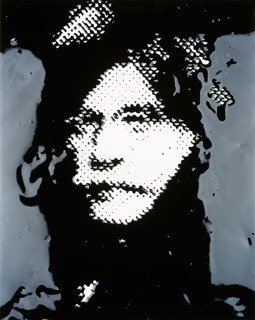Release Date: May 20, 2016
"Intersections" Explores Connections Between Newly Joined Photography Collections from National Gallery of Art and Corcoran Gallery of Art

Vik Muniz
Alfred Stieglitz (from the series Pictures of Ink), 2000
silver dye bleach print
National Gallery of Art, Washington, Corcoran Collection (Museum Purchase with funds provided by the FRIENDS of the Corcoran Gallery of Art)
Washington, DC—Intersections: Photographs and Videos from the National Gallery of Art and the Corcoran Gallery of Art explores the connections between the two newly joined photography collections. On view from May 29, 2016, through January 2, 2017, the exhibition is organized around themes found in the work of the two pioneers of each collection: Eadweard Muybridge (1830–1904) and Alfred Stieglitz (1864–1946). Inspired by these two seminal artists, Intersections brings together more than 100 highlights of the recently merged collections by a range of artists from the 1840s to today.
Just as the nearly 700 photographs from Muybridge's groundbreaking publication Animal Locomotion, acquired by the Corcoran Gallery of Art in 1887, became the foundation for the institution's early interest in photography, the Key Set of more than 1,600 works by Stieglitz, donated by Georgia O'Keeffe and the Alfred Stieglitz Estate, launched the photography collection at the National Gallery of Art in 1949.
Exhibition Support
Organized by the National Gallery of Art, the exhibition is made possible through the generous support of the Trellis Fund. Additional funding is kindly provided by Brian and Paula Ballo Dailey.
Exhibition Highlights
The exhibition is organized around five themes—movement, sequence, narrative, studio, and identity—found in the work of Muybridge and Stieglitz.
Movement: Works by Muybridge, who is best known for creating photographic technologies to stop and record motion, anchor the opening section devoted to movement. Photographs by Berenice Abbott and Harold Eugene Edgerton, which study how objects move through space, are included, as are works by Roger Mayne, Alexey Brodovitch, and other who employed the camera to isolate an instant from the flux of time.
Sequence: Muybridge set up banks of cameras and used electronic shutters triggered in sequence to analyze the motion of people and animals. Like a storyteller, he sometimes adjusted the order of images for visual and sequential impact. Other photographers have also investigated the medium's capacity to record change over time, express variations on a theme, or connect seemingly disparate pictures. In the early 1920s, Stieglitz began to create poetic sequences of cloud photographs meant to evoke distinct emotional experiences. These works (later known as Equivalents) influenced Ansel Adams and Minor White—both artists created specific sequences to evoke the rhythms of nature or the poetry of time passing.
Narrative: The exhibition also explores the narrative possibilities of photography found in the interplay of image and text in the work of Robert Frank, Larry Sultan, and Jim Goldberg; the emotional drama of personal crisis in Nan Goldin's image grids; or the expansion of photographic description into experimental video and film by Victor Burgin and Judy Fiskin.
Studio: Intersections also examines the studio as a locus of creativity, from Stieglitz's photographs of his gallery, 291, and James Van Der Zee's commercial studio portraits, to the manipulated images of Wallace Berman, Robert Heinecken, and Martha Rosler. Works by Laurie Simmons, David Levinthal, and Vik Muniz also highlight the postmodern strategy of staging images created in the studio.
Identity: Historic and contemporary works by August Sander, Diane Arbus, Lorna Simpson, and Hank Willis Thomas, among others, make up the final section, which explores the role of photography in the construction of identity.
Exhibition Curators & Related Activities
Sarah Greenough, senior curator, department of photographs, and Philip Brookman, consulting curator, department of photographs, both National Gallery of Art, are the exhibition curators.
Arnold Newman Lecture Series on Photography: Lorna Simpson
September 10 at 12:00
East Building Auditorium
Historic Agreement Between Institutions
The National Gallery of Art assumed stewardship of a world-renowned collection of paintings, sculpture, decorative arts, prints, drawings, and photographs with the closing of the Corcoran Gallery of Art in late 2014. Founded in 1869 by Washington banker and philanthropist William Wilson Corcoran (1798–1888), the Corcoran was America's first cultural institution to be established expressly as an art museum. Mr. Corcoran's founding mission of "encouraging American genius" articulated his national aspirations for the institution, and this guiding principle informed collection and exhibition strategies throughout the museum's 145-year history. The 2015–2016 acquisition of more than 9,000 works of art from the Corcoran collection of over 17,000 objects marks a transformative moment in the Gallery's history, one that deepens and expands public access to the country's diverse cultural legacy.
Press Contact:
Anabeth Guthrie, (202) 842-6804 or [email protected]
General Information
Department of Communications
National Gallery of Art
2000 South Club Drive
Landover, MD 20785
phone: (202) 842-6353
e-mail: [email protected]
NEWSLETTERS:
The Gallery also offers a broad range of newsletters for various interests. Follow this link to view the complete list.
Exhibition Press Release
Exhibition Checklist (PDF 424 kb)
Exhibition Wall Text (PDF 1.7 mb)
Historic Agreement February 2014
Corcoran Acquisitions February 2015
Contact:
Anabeth Guthrie
(202) 842-6804
[email protected]